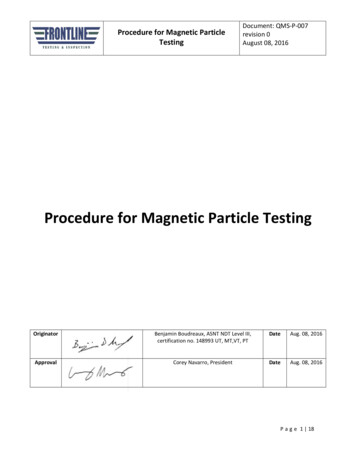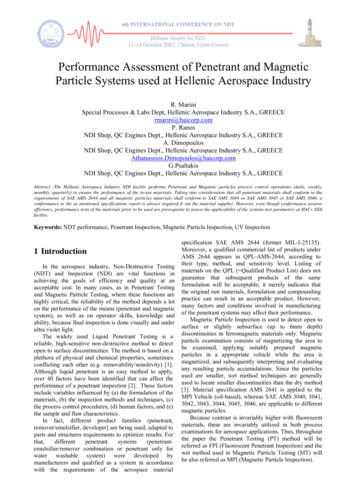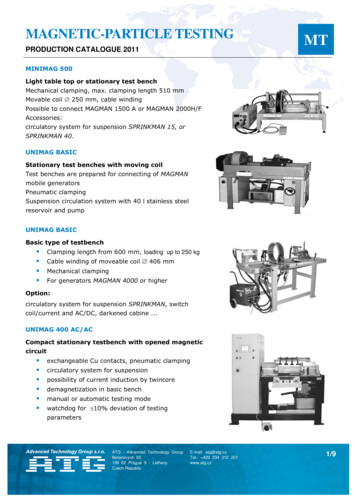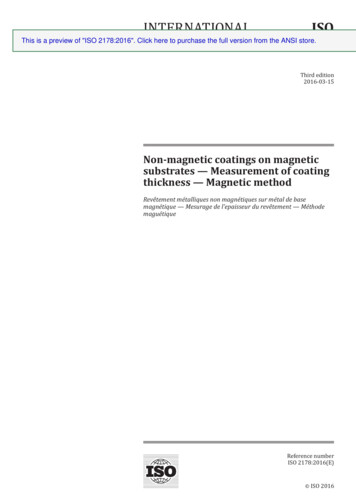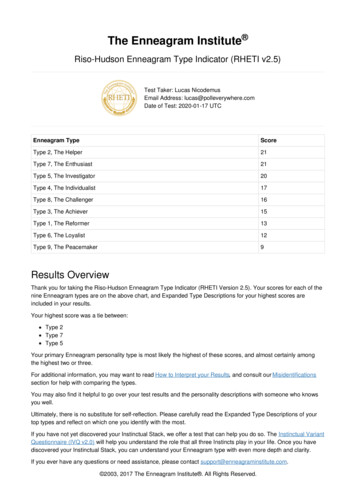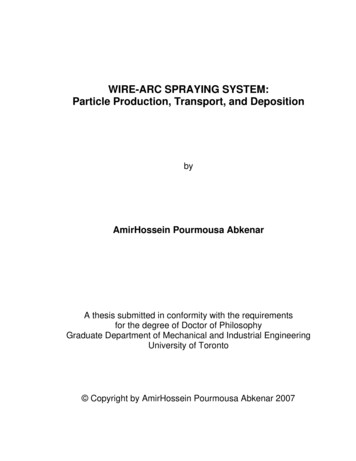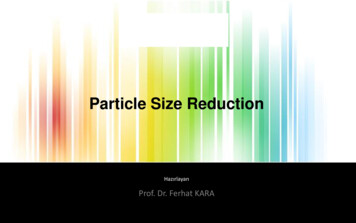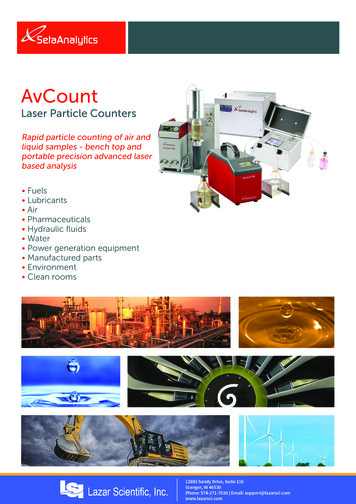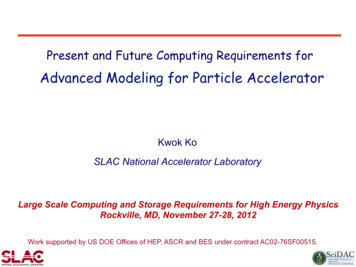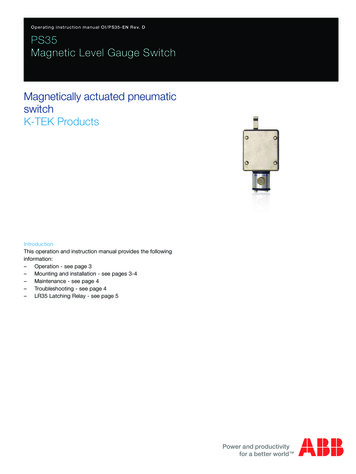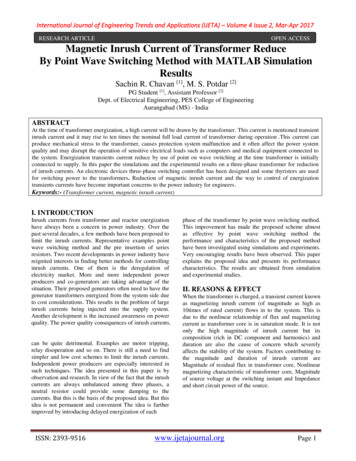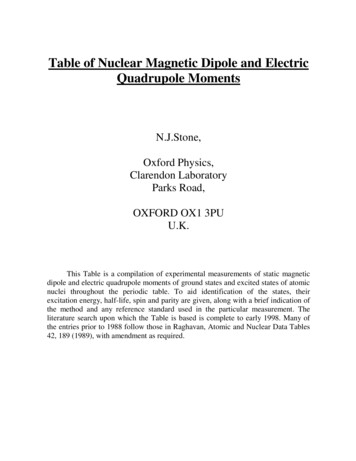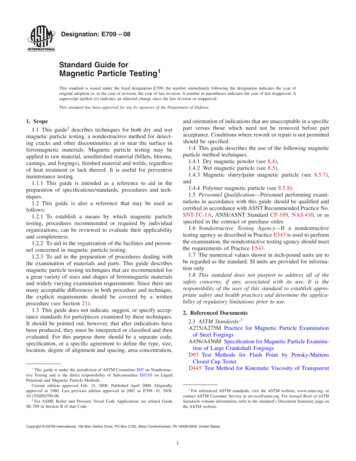
Transcription
Designation: E709 – 08Standard Guide forMagnetic Particle Testing1This standard is issued under the fixed designation E709; the number immediately following the designation indicates the year oforiginal adoption or, in the case of revision, the year of last revision. A number in parentheses indicates the year of last reapproval. Asuperscript epsilon ( ) indicates an editorial change since the last revision or reapproval.This standard has been approved for use by agencies of the Department of Defense.and orientation of indications that are unacceptable in a specificpart versus those which need not be removed before partacceptance. Conditions where rework or repair is not permittedshould be specified.1.4 This guide describes the use of the following magneticparticle method techniques.1.4.1 Dry magnetic powder (see 8.4),1.4.2 Wet magnetic particle (see 8.5),1.4.3 Magnetic slurry/paint magnetic particle (see 8.5.7),and1.4.4 Polymer magnetic particle (see 8.5.8).1.5 Personnel Qualification—Personnel performing examinations in accordance with this guide should be qualified andcertified in accordance with ASNT Recommended Practice No.SNT-TC-1A, ANSI/ASNT Standard CP-189, NAS 410, or asspecified in the contract or purchase order.1.6 Nondestructive Testing Agency—If a nondestructivetesting agency as described in Practice E543 is used to performthe examination, the nondestructive testing agency should meetthe requirements of Practice E543.1.7 The numerical values shown in inch-pound units are tobe regarded as the standard. SI units are provided for information only.1.8 This standard does not purport to address all of thesafety concerns, if any, associated with its use. It is theresponsibility of the user of this standard to establish appropriate safety and health practices and determine the applicability of regulatory limitations prior to use.1. Scope1.1 This guide2 describes techniques for both dry and wetmagnetic particle testing, a nondestructive method for detecting cracks and other discontinuities at or near the surface inferromagnetic materials. Magnetic particle testing may beapplied to raw material, semifinished material (billets, blooms,castings, and forgings), finished material and welds, regardlessof heat treatment or lack thereof. It is useful for preventivemaintenance testing.1.1.1 This guide is intended as a reference to aid in thepreparation of specifications/standards, procedures and techniques.1.2 This guide is also a reference that may be used asfollows:1.2.1 To establish a means by which magnetic particletesting, procedures recommended or required by individualorganizations, can be reviewed to evaluate their applicabilityand completeness.1.2.2 To aid in the organization of the facilities and personnel concerned in magnetic particle testing.1.2.3 To aid in the preparation of procedures dealing withthe examination of materials and parts. This guide describesmagnetic particle testing techniques that are recommended fora great variety of sizes and shapes of ferromagnetic materialsand widely varying examination requirements. Since there aremany acceptable differences in both procedure and technique,the explicit requirements should be covered by a writtenprocedure (see Section 21).1.3 This guide does not indicate, suggest, or specify acceptance standards for parts/pieces examined by these techniques.It should be pointed out, however, that after indications havebeen produced, they must be interpreted or classified and thenevaluated. For this purpose there should be a separate code,specification, or a specific agreement to define the type, size,location, degree of alignment and spacing, area concentration,2. Referenced Documents2.1 ASTM Standards:3A275/A275M Practice for Magnetic Particle Examinationof Steel ForgingsA456/A456M Specification for Magnetic Particle Examination of Large Crankshaft ForgingsD93 Test Methods for Flash Point by Pensky-MartensClosed Cup TesterD445 Test Method for Kinematic Viscosity of Transparent1This guide is under the jurisdiction of ASTM Committee E07 on Nondestructive Testing and is the direct responsibility of Subcommittee E07.03 on LiquidPenetrant and Magnetic Particle Methods.Current edition approved Feb. 15, 2008. Published April 2008. Originallyapproved in 1980. Last previous edition approved in 2001 as E709 - 01. DOI:10.1520/E0709-08.2For ASME Boiler and Pressure Vessel Code Applications see related GuideSE-709 in Section II of that Code.3For referenced ASTM standards, visit the ASTM website, www.astm.org, orcontact ASTM Customer Service at service@astm.org. For Annual Book of ASTMStandards volume information, refer to the standard’s Document Summary page onthe ASTM website.Copyright ASTM International, 100 Barr Harbor Drive, PO Box C700, West Conshohocken, PA 19428-2959, United States.1
E709 – 08and Opaque Liquids (and Calculation of Dynamic Viscosity)E165 Practice for Liquid Penetrant Examination for GeneralIndustryE543 Specification for Agencies Performing Nondestructive TestingE1316 Terminology for Nondestructive ExaminationsE1444 Practice for Magnetic Particle TestingE2297 Guide for Use of UV-A and Visible Light Sourcesand Meters used in the Liquid Penetrant and MagneticParticle Methods2.2 Society of Automotive Engineers (SAE): AerospaceMaterials Specifications:4AMS 2300 Premium Aircraft Quality Steel CleanlinessMagnetic Particle Inspection ProcedureAMS 2301 Aircraft Quality Steel Cleanliness Magnetic Particle Inspection ProcedureAMS 2303 Aircraft Quality Steel Cleanliness MartensiticCorrosion Resistant Steels Magnetic Particle InspectionProcedureAMS 2641 Vehicle Magnetic Particle InspectionAMS 3040 Magnetic Particles, Non-fluorescent, DryMethodAMS 3041 Magnetic Particles, Non-fluorescent, WetMethod, Oil Vehicle, Ready to UseAMS 3042 Magnetic Particles, Non-fluorescent, WetMethod, Dry PowderAMS 3043 Magnetic Particles, Non-fluorescent, Oil Vehicle, Aerosol PackagedAMS 3044 Magnetic Particles, Fluorescent, Wet Method,Dry PowderAMS 3045 Magnetic Particles, Non-fluorescent, WetMethod, Oil Vehicle, Ready to UseAMS 3046 Magnetic Particles, Non-fluorescent, WetMethod, Oil Vehicle, Aerosol PackagedAMS 5062 Steel, Low Carbon Bars, Forgings, Tubing,Sheet, Strip, and Plate 0.25 Carbon, MaximumAMS 5355 Investment CastingsAMS-I-83387 Inspection Process, Magnetic RubberAS 4792 Water Conditioning Agents for Aqueous MagneticParticle InspectionAS 5282 Tool Steel Ring Standard for Magnetic ParticleInspectionAS 5371 Reference Standards Notched Shims for MagneticParticle Inspection2.3 American Society for Nondestructive Testing:5SNT-TC-1A Personnel Qualification and Certification inNondestructive TestingCP-189 ASNT Qualification and Certification of Nondestructive Testing Personnel2.4 Federal Standards:6A-A-59230 Fluid, Magnetic Particle Inspection, SuspensionFED-STD 313 Material Safety Data Sheets Preparation andthe Submission of2.5 OSHA Document:729CFR 1910.1200 Hazard Communication2.6 AIA Documents:8NAS 410 Nondestructive Testing Personnel Qualificationand Certification3. Terminology3.1 For definitions of terms used in the practice, refer toTerminology E13164. Summary of Guide4.1 Principle—The magnetic particle method is based onestablishing a magnetic field with high flux density in aferromagnetic material. The flux lines must spread out whenthey pass through non-ferromagnetic material such as air in adiscontinuity or an inclusion. Because flux lines can not cross,this spreading action may force some of the flux lines out of thematerial (flux leakage). Flux leakage is also caused by reduction in ferromagnetic material (cross-sectional change), a sharpdimensional change, or the end of the part. If the flux leakageis strong enough, fine magnetic particles will be held in placeand an accumulation of particles will be visible under theproper lighting conditions. While there are variations in themagnetic particle method, they all are dependent on thisprinciple, that magnetic particles will be retained at thelocations of magnetic flux leakage. The amount of flux leakageat discontinuities depends primarily on the following factors;flux density in the material, and size, orientation, and proximityto the surface of a discontinuity. With longitudinal fields, all ofthe flux lines must complete their loops though air and anexcessively strong magnetic field may interfere with examination near the flux entry and exit points due to the highflux-density present at these points.4.2 Method—While this practice permits and describesmany variables in equipment, materials, and procedures, thereare three steps essential to the method:4.2.1 The part must be magnetized.4.2.2 Magnetic particles of the type designated in thecontract/purchase order/specification should be applied whilethe part is magnetized or immediately thereafter.4.2.3 Any accumulation of magnetic particles must beobserved, interpreted, and evaluated.4.3 Magnetization:4.3.1 Ways to Magnetize—A ferromagnetic material can bemagnetized either by passing an electric current through thematerial or by placing the material within a magnetic fieldoriginated by an external source. The entire mass or a portionof the mass can be magnetized as dictated by size andequipment capacity or need. As previously noted, in order to bedetectable, the discontinuity must interrupt the normal path ofthe magnetic field lines. If a discontinuity is open to the4Available from Society of Automotive Engineers (SAE), 400 CommonwealthDr., Warrendale, PA 15096-0001, http://www.sae.org.5Available from American Society for Nondestructive Testing (ASNT), P.O. Box28518, 1711 Arlingate Ln., Columbus, OH 43228-0518, http://www.asnt.org.6Available from Standardization Documents Order Desk, DODSSP, Bldg. 4,Section D, 700 Robbins Ave., Philadelphia, PA 19111-5098, http://www.dodssp.daps.mil.7Available from Occupational Safety and Health Administration (OSHA), 200Constitution Ave., NW, Washington, DC 20210, http://www.osha.gov.8Available from Aerospace Industries Association of America, Inc. (AIA), 1000Wilson Blvd., Suite 1700, Arlington, VA 22209-3928, http://www.aia-aerospace.org.2
E709 – 08surface. The patterns tend to be broad, rather than sharp, andthe particles are less tightly held (see Annex A1).surface, the flux leakage attracting the particles will be at themaximum value for that particular discontinuity. When thatsame discontinuity is below the surface, flux leakage evidenton the surface will be a lesser value.4.3.2 Field Direction—If a discontinuity is oriented parallelto the magnetic field lines, it may be essentially undetectable.Therefore, since discontinuities may occur in any orientation, itmay be necessary to magnetize the part or the area of interesttwice or more sequentially in different directions by the samemethod or a combination of different methods (see Section 13)to induce magnetic field lines in a suitable direction in whichto perform an adequate examination.4.3.3 Field Strength—The magnetic field must be of sufficient strength to indicate those discontinuities which areunacceptable, yet must not be so strong that an excess of localparticle accumulation masks relevant indications (see Section14).4.4 Types of Magnetic Particles and Their Use—There arevarious types of magnetic particles available for use in magnetic particle testing. They are available as dry powders(fluorescent and nonfluorescent) ready for use as supplied (see8.4), powder concentrates (fluorescent and nonfluorescent) fordispersion in water or suspending in light petroleum distillates(see 8.5), magnetic slurries/paints (see 8.5.7), and magneticpolymer dispersions (see 8.5.8).4.5 Evaluation of Indications—When the material to beexamined has been properly magnetized, the magnetic particleshave been properly applied, and the excess particles properlyremoved, there will be accumulations of magnetic particlesremaining at the points of flux leakage. These accumulationsshow the distortion of the magnetic field and are calledindications. Without disturbing the particles, the indicationsmust be examined, classified, compared with the acceptancestandards, and a decision made concerning the disposition ofthe material that contains the indication.4.6 Typical Magnetic Particle Indications:4.6.1 Surface Discontinuities—Surface discontinuities, withfew exceptions, produce sharp, distinct patterns (see AnnexA1).4.6.2 Near-surface discontinuities—Near-surface discontinuities produce less distinct indications than those open to the5. Significance and Use5.1 The magnetic particle method of nondestructive testingindicates the presence of surface and near-surface discontinuities in materials that can be magnetized (ferromagnetic). Thismethod can be used for production examination of parts/components or structures and for field applications whereportability of equipment and accessibility to the area to beexamined are factors. The ability of the method to find smalldiscontinuities can be enhanced by using fluorescent particlessuspended in a suitable vehicle and by introducing a magneticfield of the proper strength whose orientation is as close aspossible to 90 to the direction of the suspected discontinuity(see 4.3.2). A smoother surface or a pulsed current improvesmobility of the magnetic particles under the influence of themagnetic field to collect on the surface where magnetic fluxleakage occurs.6. Equipment6.1 Types—There are a number of types of equipmentavailable for magnetizing ferromagnetic parts and components.With the exception of a permanent magnet, all equipmentrequires a power source capable of delivering the requiredcurrent levels to produce the magnetic field. The current useddictates the sizes of cables and the capability of relays,switching contacts, meters and rectifier if the power source isalternating current.6.2 Portability—Portability, which includes the ability tohand carry the equipment, can be obtained from yokes,portable coils with power supplies, and capacitor dischargepower supplies with cables
Standard Guide for. Magnetic Particle Testing1. This standard is issued under the fixed designation E709; the number immediately following the designation indicates the year of original adoption or, in the case of revision, the year of last revision. A number in parentheses indicates the year of last reapproval.File Size: 1MBPage Count: 41Explore furtherASTM E709 - 15 Standard Guide for Magnetic Particle Testingwww.astm.org[PDF] ASTM-E709 - Free Download PDFdlscrib.comProcedure for Magnetic Particle Testingwww.frontlinetesting.comASTM E3024 / E3024M - 19 Standard Practice for Magnetic .www.astm.orgASTM E709 Standard Guide for Magnetic Particle Testing .www.scribd.comRecommended to you based on what's popular Feedback
